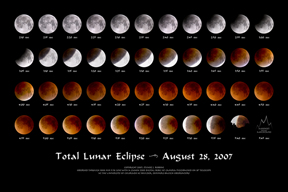One of the neatest and most transiet of events with the Moon are eclipses - when one celestial body passes in front of another. The more common of the two types of eclipses involving our Moon is the lunar eclipse, when the Earth passes between the Sun and Moon, and part of it is blocked, or turns blood red. This happens twice a year, but it is visible only from about 1/3 of the globe, and it isn't always a total eclipse or even an umbral eclipse (when it turns red).
One of the most common questions about lunar eclipses is why they appear red. It's the same reason that the sky appears blue. The sky looks blue because our atmosphere scatters shorter, bluer, light more easily than red light. But, the longer the light travels through the atmosphere, the more longer, redder, light is scattered. That's why sunsets and sunrises appear red. With a lunar eclipse, or at least a total lunar eclipse, the only light that the moon is reflecting is light that passes to it through Earth's atmosphere, and so only the reddest light gets to the moon to reflect back to our eyes (or cameras).
